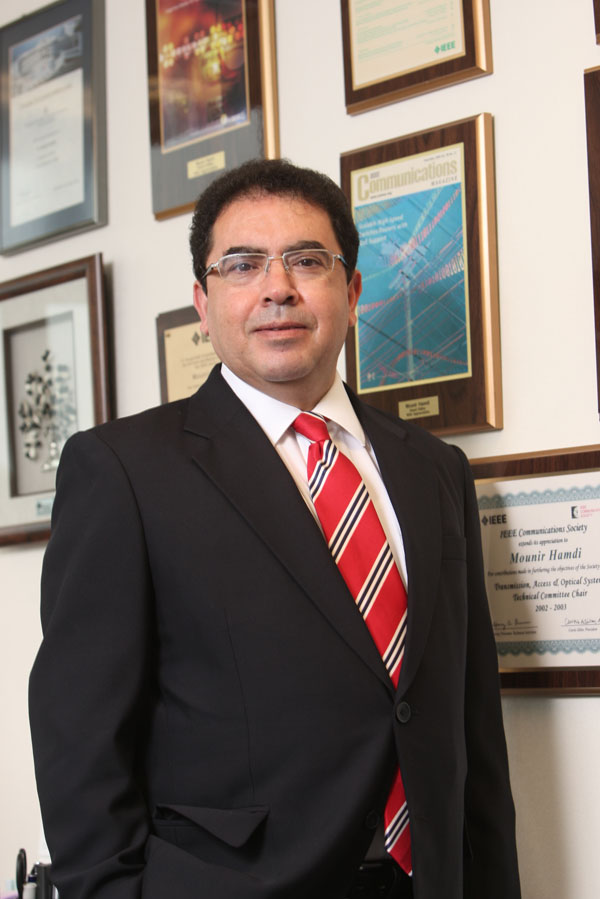Keynote Speakers
| Prof. Mounir Hamdi | Dr. Han-Chieh Chao |
|---|
 |
Head & Chair Professor, IEEE FellowDepartment of Computer Science and EngineeringHong Kong University of Science and Technology |
|---|
Building Next Generation Massive Data Centers
Abstract: Data center infrastructure design has recently been receiving significant research interest both from academia and industry, in no small part due to the growing importance of data centers in supporting and sustaining the rapidly growing web-based applications including search (e.g., Google, Bing), video content hosting and distribution (e.g., YouTube, NetFlix), social networking (e.g., facebook, twitter), and large-scale computations (e.g., data mining, bioinformatics, indexing).
Today's data centers may contain tens of thousands of computers with significant aggregate bandwidth requirements. For example, the Microsoft Live online services are supported by a Chicago-based data center, which is one of the largest data centers ever built, spanning more than 700,000 square feet, and Google has more than 1 Million servers.
As a result, the architecture of the network interconnecting the servers has a significant impact on the agility and reconfigurability of the data center infrastructure to respond to changing application demands and service requirements. Traditionally data center networking was based around top of rack (ToR) switches interconnected through end of rack (EoR) switches, and these in turn are being connected through core switches. This approach, besides being very costly, leads to significant bandwidth oversubscription towards the network core. This prompted several researchers to suggest alternate approaches for scalable cost-effective network infrastructures, based on topologies including Fat-Tree, DCell, BCube, MDCube, and Clos network.
In this talk, we detail the trends and challenges in designing massive data centers. We will highlight the research efforts being undertaken by the academic and industrial communities to address these challenges. Finally, we present some of our own solutions by leveraging the key data traffic patterns and web-applications in achieving scalable and cost effective solutions to the design of massive data centers infrastructures.
About Prof. Mounir Hamdi
Mounir Hamdi is a Chair Professor at the Hong Kong University of Science and Technology, and the Head of the Department of Computer Science and Engineering. He is an IEEE Fellow for contributions to design and analysis of high-speed packet switching.
He received the B.S. degree in Electrical Engineering - Computer Engineering minor (with distinction) from the University of Louisiana in 1985, and the MS and the PhD degrees in Electrical Engineering from the University of Pittsburgh in 1987 and 1991, respectively.
He has been a faculty member in the Department of Computer Science and Engineering at the Hong Kong University of Science and Technology since 1991, where he was a founding member of the University and the Department. He is now the Head and Chair Professor of the Department that has around 800 undergraduate and graduate students. He was the Director of the Computer Engineering Program (for 10 years) that has around 330 undergraduate students, Director of the Master of Science in Information Technology (for 3 years) which has more than 150 graduate students, and Director of the Computer Engineering research Lab. He is/was a member of the University Senate and University Council. In 1999 to 2000 he held visiting professor positions at Stanford University, USA, and the Swiss Federal Institute of Technology, Lausanne, Switzerland. His general area of research is in high-speed wired/wireless networking in which he has published around 300 research publications, received numerous research grants, and graduated more 30 graduate students. In addition, he has frequently consulted for companies and governmental organizations in the USA, Europe and Asia on high-performance Internet routers and switches as well as high-speed wireless LANs. He is a frequent keynote speaker in International Conferences and Forums.
Prof. Hamdi is/was on the Editorial Board of various prestigious journals and magazines including IEEE Transactions on Communications, IEEE Communication Magazine, Computer Networks, Wireless Communications and Mobile Computing, and Parallel Computing as well as a guest editor of IEEE Communications Magazine, guest editor-in-chief of two special issues of IEEE Journal on Selected Areas of Communications, and a guest editor of Optical Networks Magazine. He has chaired more than 20 international conferences and workshops including The IEEE International High Performance Switching and Routing Conference, the IEEE GLOBECOM/ICC Optical networking workshop, the IEEE ICC High-speed Access Workshop, and the IEEE IPPS HiNets Workshop, and has been on the program committees of more than 200 international conferences and workshops. He was the Chair of IEEE Communications Society Technical Committee on Transmissions, Access and Optical Systems, and Vice-Chair of the Optical Networking Technical Committee, as well as member of the ComSoc technical activities council. He received the best paper award at the IEEE International Conference on Communications in 2009 and the IEEE International Conference on Information and Networking in 1998. He also supervised the best PhD paper award amongst all universities in Hong Kong.
In addition to his commitment to research and professional service, he is also a dedicated teacher and renowned quality-assurance educator. He received the best 10 lecturers award (through university-wide student voting for all university faculty held once a year), the distinguished engineering teaching appreciation award from the Hong Kong University of Science and Technology, and various grants targeted towards the improvement of teaching methodologies, delivery and technology. He is frequently involved in higher education quality assurance activities as well as engineering programs accreditation.
